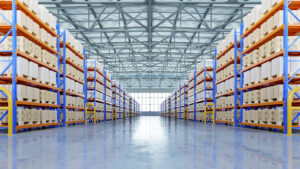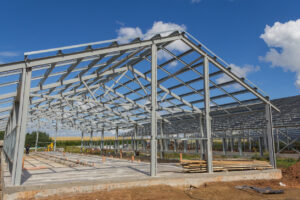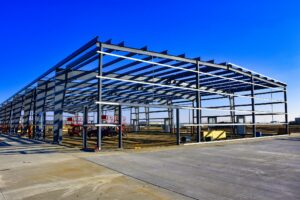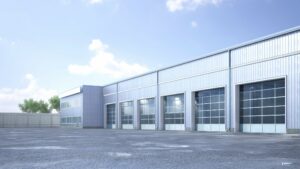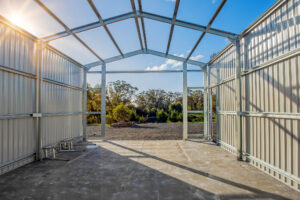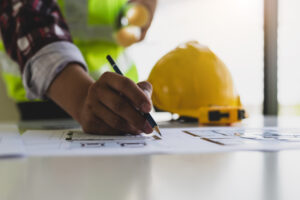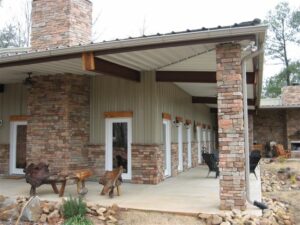If you are considering investing in a 100 x 200 steel building, it’s important to understand the various costs involved.
Steel buildings have become increasingly popular in the U.S. construction industry, due to their durability, versatility, and cost-effectiveness. They are being used not only in commercial and industrial operations but also in public, government, and residential sectors.
The market has seen a significant expansion over the past decades, with general contractors stating that metal building projects make up more than half (60%) of their revenue.
From the basics of steel building pricing to ways to reduce the overall cost, this article will guide you through the financial aspects of a steelbuilding project.
Understanding the Basics of Steel Building Pricing
Before detailing the specific costs, it is essential to have a solid understanding of the factors that influence the pricing of steel buildings. By doing so, you can better manage your budget and make informed decisions.
When considering steel building pricing, it’s crucial to take into account several key factors that can impact the overall cost.
Factors Influencing the Cost of Steel Buildings
Several key factors impact the overall cost of a steel building:
- The size and dimensions of your building
- Customization and design options
- The complexity of the building’s structure
- Regional pricing variations
- Site preparation and foundation requirements
By carefully considering each of these factors, you can more accurately estimate the cost of your 100 x 200 steel building.
The size and dimensions of the steel building play a significant role in determining the overall cost. Larger buildings require more materials and labor, leading to higher expenses.
Customization options, such as adding windows, doors, insulation, and finishes, can also impact the final price. The complexity of the building’s structure, including the roof design and additional features like mezzanines or cranes, can add to the overall cost.
Regional pricing variations take into account factors such as local labor costs, building codes, and material availability, which can vary from one location to another. Site preparation and foundation requirements are crucial considerations, as the condition of the site and the type of foundation needed can affect costs significantly.
Did You Know?
Building codes vary significantly from state to state. Each state has its own specific regulations and requirements for construction projects. SteelCo ensures compliance by providing customers with stamped engineering plans that comply with local zoning rules, building code regulations, and other ordinances.
Pricing Structure for Steel Buildings
Steel building pricing structure is typically divided into three main components:
- Material expenses
- Labor and installation costs
- Additional expenses
Understanding how these costs are structured will help you allocate your budget effectively.
Material expenses include the cost of steel components, insulation, roofing materials, and finishes. Labor and installation costs cover the wages of construction workers, as well as the assembly and erection of the steel building.
Additional expenses may include permits, engineering services, transportation costs, and any unforeseen expenses that may arise during the construction process. By breaking down the pricing structure into these components, you can better assess where your budget is allocated and make adjustments as needed.
Breakdown of Costs for a 100 x 200 Steel Building
Cost of Steel and Material Expenses
The cost of steel and other materials is a significant portion of the overall expenses. Pricing for steel can vary depending on market conditions and quality. Steel is a versatile and durable material, making it a popular choice for constructing large buildings like a 100 x 200 steel building.
In addition to steel, other materials such as insulation, roofing panels, doors, windows, and interior finishes like drywall and flooring contribute to the total material expenses. Each of these materials comes with cost considerations and quality options, impacting the overall budget.
Labor and Installation Costs
The costs associated with labor and installation will depend on several factors, including the complexity of the building design and the experience of the construction team.
Skilled labor is crucial for ensuring the structural integrity and safety of the steel building. Installation costs may also vary based on the location of the construction site, accessibility, and any special equipment needed for assembly. It’s essential to work with reputable contractors who have experience in erecting steel buildings and can provide accurate cost estimates for these services.
Additional Expenses to Consider
When budgeting for your 100 x 200 steel building, it’s essential to account for additional expenses that may arise. Beyond the costs of materials and labor, there are various other expenses to consider. Permits and inspections are necessary steps in the construction process to ensure compliance with building codes and regulations.
Additionally, factors like HVAC systems, electrical wiring for lighting and equipment, plumbing for restrooms or kitchen areas, and finishing touches such as paint and landscaping can all add to the overall project costs. Proper planning, thorough research, and clear communication with all involved parties will help prevent any unforeseen expenses and keep the project on budget.
Cost Comparison: Steel Buildings vs. Other Structures
Price Differences Based on Material
Comparing the costs of steel buildings to other construction materials, such as wood or concrete, reveals distinct cost advantages. Steel buildings generally have lower upfront costs due to their prefabricated components and efficient construction processes.
Steel buildings are not only cost-effective but also environmentally friendly. Steel is one of the most recycled materials in the world, making it a sustainable choice for construction projects. By choosing steel, you are contributing to the reduction of waste and the conservation of natural resources.
Pro tip:
Choosing a steel isn’t just a practical decision; it’s a smart investment in the future of your construction projects. Beyond the initial cost savings and durability benefits, steel structures also offer environmental advantages.
Long-term Cost Efficiency of Steel Buildings
While steel buildings may have a slightly higher initial price tag, they offer long-term cost efficiency. Steel is incredibly durable and requires minimal maintenance over its lifespan, making it a cost-effective investment in the long run. Additionally, steel buildings have excellent energy efficiency, resulting in lower utility bills.
Another advantage of steel buildings is their versatility in design. Steel allows for large open spaces without the need for supporting columns, providing flexibility in layout and usage. This flexibility can lead to cost savings in terms of interior finishing and future modifications to the building.
Ways to Reduce the Cost of Your Steel Building
Choosing Cost-Effective Design Options
Opting for simpler design elements and standardized sizes can help reduce costs. Avoid excessive customization and unnecessary features that might increase labor and material expenses. Working closely with an experienced steel building provider can help you make the most cost-effective design choices.
Consider utilizing pre-engineered building systems that offer a range of design options at competitive prices. These systems are designed to streamline the construction process, saving both time and money. Additionally, incorporating energy-efficient features into your steel building can lead to long-term cost savings through reduced utility bills.
Tips for Negotiating with Suppliers
Don’t be afraid to negotiate with steel building suppliers. By comparing quotes from multiple suppliers and leveraging your options, you can potentially secure better prices and favorable terms. Building strong relationships with suppliers can also lead to future cost savings.
When negotiating with suppliers, inquire about bulk discounts for purchasing materials in larger quantities. Additionally, exploring alternative material options or delivery schedules can help lower costs without compromising quality. By being proactive in your negotiations and seeking out cost-saving opportunities, you can effectively reduce the overall expenses of your steel building project.
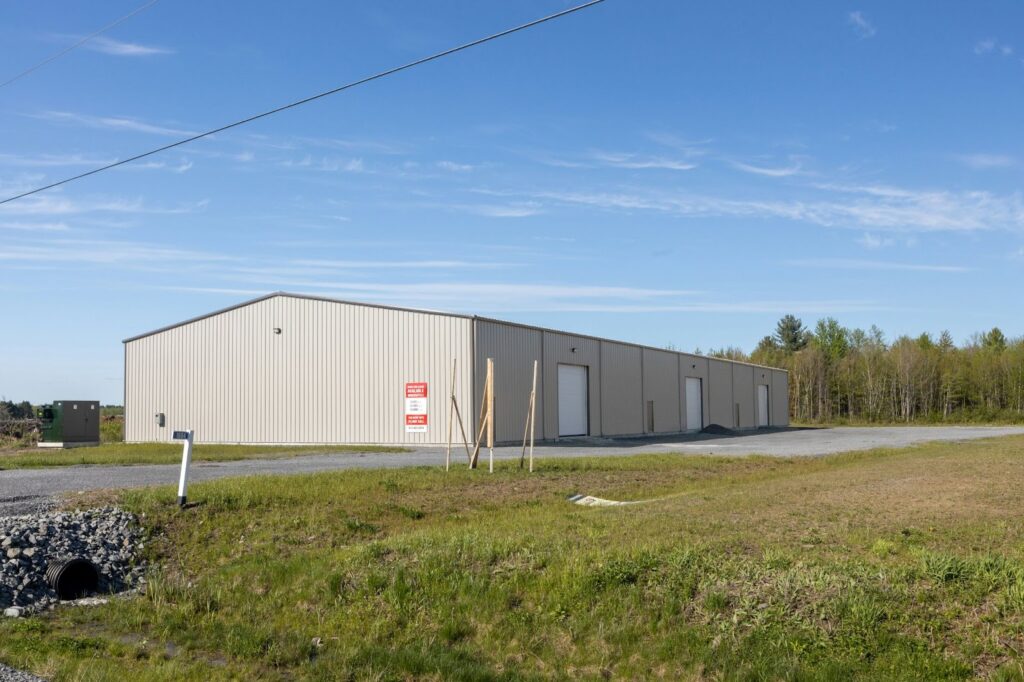
Financing Options for Your Steel Building
Understanding Construction Loans
If you require financial assistance for your steel building project, construction loans are a viable option. These loans provide funding for the construction phase. Once the building is complete, it can be refinanced into a permanent mortgage or paid off entirely.
Construction loans typically have variable interest rates and short terms, usually around one year. During the construction phase, the borrower pays interest only on the outstanding balance. Once the project is finished, the loan can be converted into a traditional mortgage. It’s important to note that lenders may require a larger down payment for construction loans compared to permanent mortgages.
Exploring Lease-to-Own Options
Lease-to-own programs are an alternative financing solution to consider. These programs allow you to lease the steel building with the option to purchase it at the end of the lease period.
This option can provide flexibility, especially for businesses or individuals with limited upfront capital.Lease-to-own agreements typically involve a fixed lease term, during which a portion of the lease payments may go toward the purchase price if the lessee decides to buy the building. This can be beneficial for those who want to test the suitability of the steel building for their needs before committing to a purchase.
Additionally, lease-to-own options may offer tax advantages and the ability to negotiate favorable terms based on the individual circumstances of the agreement.
Conclusion
A 100 x 200 steel building requires careful consideration of the various costs involved. Understanding the basics of steel building pricing, including the factors influencing cost and the pricing structure, is vital for effective budget allocation. Steel is an inexpensive building material, that is also sturdy and long-lasting. Not only is steel less expensive than other materials, but because of its durability you’ll also be able to amortize the cost over time.
Generally speaking, warehouses are difficult to price accurately due to the level of customizations, and other factors such as eave height, roof pitch, entryways, etc. but in 2024 ballpark ranges are $17 to $20 per square feet and $6 to $10 SF for steel erection. This can also be highly variable based on supply/demand and other market factors.
For a 20,000 SF steel building, this equates to roughly $460,000 to $600,000 for just PEMB materials and steel erection.
SteelCo ships prefabricated metal building kits all over the country directly from our suppliers to your project/building location. Our decades of experience in custom pre-engineered metal buildings (PEMB) ensures a smooth process, with top-quality pre-engineered steel panels, framing, roofing, and other materials also packaged potentially together for cost savings and decreased project timelines.
If you have a specific design for your steel building construction, we can help bring it to life. Contact us to learn more.










